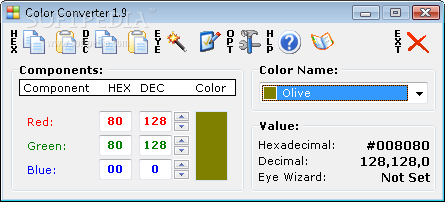
This converter can be used both within bindings and in code-behind to give more concise property setters.
Wpf colorconverter code#
the brush that is mapped to the Boolean false value) to demonstrate both concepts. new SolidColorBrush (Color.FromArgb (0x44, 0xFF, 0xFF, 0)) ( Documentation) Note: Dont use Color.FromRgb () (without the A) if your code will be shared in both Silverlight and WPF, as the FromRgb method doesnt exist in Silverlight. This post provides a simple IValueConverter implementation that makes use of the framework type converters in order to convert between a large range of source / target types. the brush that is mapped to the Boolean true value) and declares a new gray SolidColorBrush for the FalseBrush (i.e. This snippet uses an existing resource for the TrueBrush (i.e. The next code snippet shows how an instance of this BooleanToBrushConverter is declared in the Resources section of a user interface element. Public class BooleanToBrushConverter : DependencyObject, IValueConverter
Place a textbox and a checkbox into the Grid. Open MainPage.xaml from Solution Explorer.
Wpf colorconverter how to#
My idea on how to do this is a simply store. Now, we are going to place controls using XAML code. I have a wpf application in which I'd like to convert a color of radio button to (Green/Red) compared to a boolean value : In Xaml FileWe created it with just a rectangular user control and created a 4 column grid, so all we need to do is change either the background or foreground color of the control. Part of the app is a signal strength bar. The first code block show the implementation of the converter class. I am making a WPF application using the MVVM design pattern. Everything fully declarative in my XAML file without a single line of C# code. BooleanToBrushConverter exposes two dependency properties TrueBrush and FalseBrush and by providing values for these properties, the Boolean values true and false are mapped to Brush objects in the user interface accordingly. This converter class is intended to be used whenever a Boolean property is data bound to some UI element’s brush. In fact, I encountered this use case that often, that I decided to cover it in a custom converter class called BooleanToBrushConverter, which implements this functionality.

The most common case for that is possibly an active / inactive state of a ViewModel which should reflect in the user interface.
Wpf colorconverter windows#
Public Function ConvertBack(value As Object, targetType As Type, parameter As Object, culture As Globalization.CultureInfo) As Object Implements IValueConverter.NET C# Windows Phone Windows Phone 7 WP7 Silverlight WPF MVVMĪ common use case in Windows Phone (or generally Silverlight / WPF) development is having to change a UI element’s color (background and/or foreground) depending on a Boolean state in your ViewModel.

Return CType(value, Visibility) = Visibility.Visible If value = False Then V = Visibility.Collapsed Public Function Convert(value As Object, targetType As Type, parameter As Object, culture As Globalization.CultureInfo) As Object Implements IValueConverter.Convert **Here's the complete resource dictionary: I'm guessing I've missed something, but can't figure it out. Public Function ConvertBack(value As Object, targetType As Type, parameter As Object, culture As Globalization.CultureInfo) As Object Implements IValueConverter.ConvertBack The ColorConverter code is Public Function Convert(value As Object, targetType As Type, parameter As Object, culture As Globalization.CultureInfo) As Object Implements IValueConverter.Convert Theoretically this should work, but it's coming out white. I am creating a control template for a checkbox, all is going well but I would like to use a gradient that is bound to the Foreground color.


 0 kommentar(er)
0 kommentar(er)
